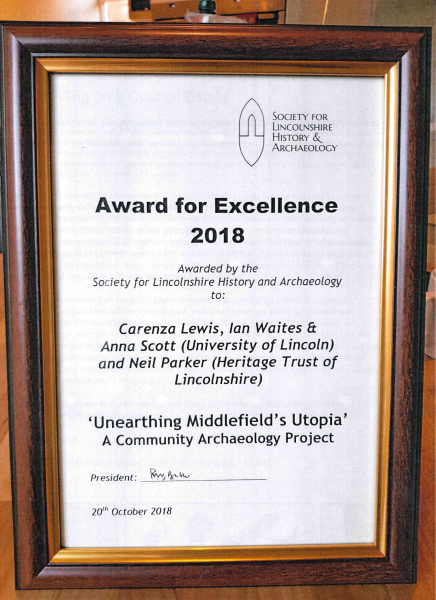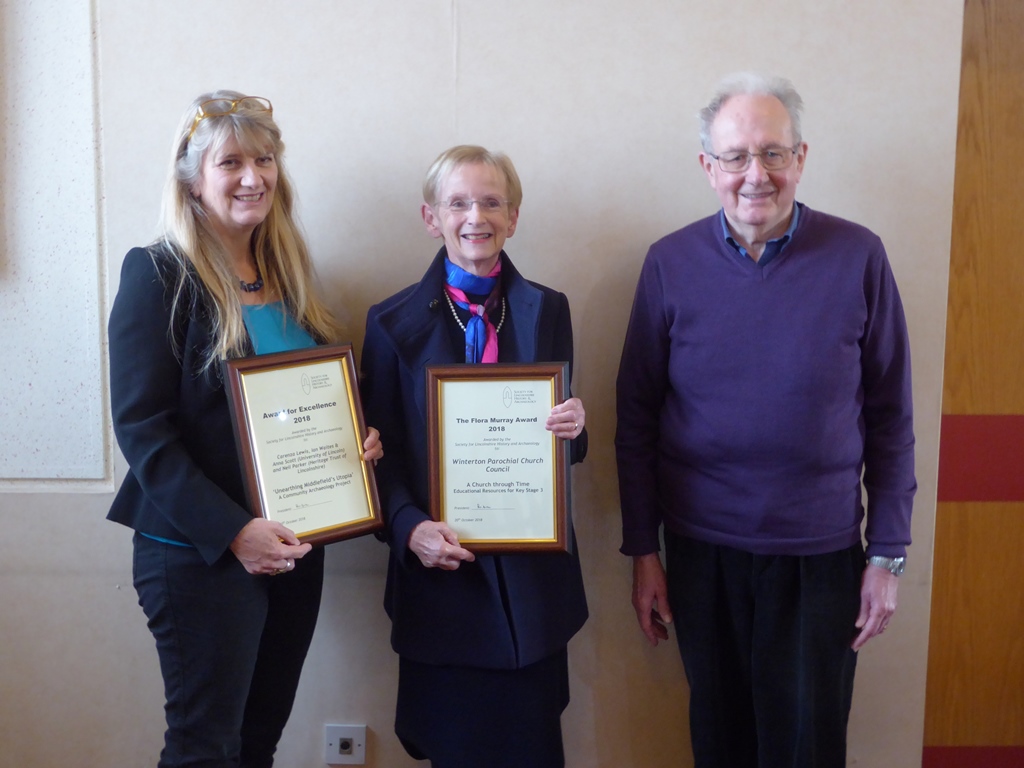Excellence in Archaeology

In 2016, the Arts and Humanities Council funded Professor Carenza Lewis (well-known from Channel 4’s Time Team) and Dr Ian Waites at the University of Lincoln to carry out a project called ‘Middlefield’s Utopia’. The aim was to explore the archaeology of a post-war council estate in Gainsborough. This estate is important as its 1960s architects designed it following planning ideals pioneered in the 1920s at Radburn in New Jersey. The garden city movement, in turn, inspired this. The Radburn design featured houses fronting onto open green spaces which separated driving and pedestrian areas. This encouraged socialising between neighbours and provide safe spaces for children to play. APS supported the Gainsborough project by supervising the excavation of 20 one-metre square test pits carried out by local residents. They dug test pits in a number of locations. Including pedestrianised greens, roadside greens and within the local school. APS also undertook the post-excavation finds analysis and some of the background research. The excavations revealed two new aspects of the site’s history. One from the 17th-19th century and the other from the 20th century.
The Middlefield area in the 17th-19th century
The majority of the pottery found was post-medieval, mainly of the 17th to 19th centuries.
Most came from more expensive drinking vessels, dishes and plates, with unusually little of the more utilitarian domestic storage vessels. It was surprising to find so much pottery from these periods. At that time the area was farmland, so the pottery finds may be due to the infrastructure of these periods. With no sewers and no weekly bin emptying like today. The refuse (including human sewage) became increasingly problematic as towns grew in size. In some places this was collected as ‘night soil’ which was spread on surrounding fields where the organic refuse added nutrients to the soil. Any broken pottery included with this rubbish would also get spread on the fields. Archaeologists today find the remains of this pottery, as it does not decompose like other materials.
The Middlefield Lane estate in the 20th century
Many of the finds from the 20th century layers in the gardens of the estate are the casual loss from children playing. Artefacts such as a toy fireman and a small black plastic cat. Volunteers also found similar items such as sweet wrappers, bits of toy soldiers, ring pulls (the old, detachable type), the wheel from a toy car, a Smarties tube top and several marbles in the communal areas. A typical pastime in the area for bored children was to try and smash marbles against the wall. So it was very telling when we found a smashed marble in one of the test pits! The 1960s planners had intended that these areas would be a communal, social space. So the fact that so much of the detritus related to children shows that this design was successful. Indeed, during the excavations, children were playing on the grass near the test pits in just the same fashion, and feedback showed the experience of participating in the excavations had a positive impact of local residents who gained new skills and learned about the historical significance of ‘their’ estate.
Future
We are looking forwards to seeing how this project progresses. But for now we want to say thank you to the project leads Professor Carenza Lewis and Dr Ian Waites at the University of Lincoln for inviting us to be involved.
Find out more about the project here
Winterton All Saints Church
At the same meeting, the Society presented the Flora Murray award to a project focused on Winterton All Saint’s church that our colleagues at Heritage Lincolnshire also collaborated on. Winterton. All Saint’s Church has been undergoing vital restoration works, funded by the Heritage Lottery Fund. A condition of the funding was that the church created activities to help bring other people into the church, to benefit from the space – a key project outcome as far as the Winterton PCC were concerned! They invited the Heritage Trust of Lincolnshire to design educational resources to use in the church, with children from both the local primary and secondary schools. The first half saw the children exploring the history of the church, and in the second half, we explored the history of Winterton itself, focusing particularly on the Romans, as the remains of a Roman villa were found in the village. The children had a great time, and were able to get used to the new space that is available to them. The school and the church have continued their great relationship, and everyone is benefiting from the restoration.

